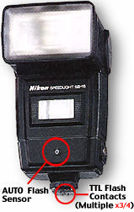Flash photography in FM3a provides a new dimension to the mechanical FM series SLRs because as for the first time, TTL OTF flash exposure control is being incorporated into a mechanical Nikon SLR body. The form used is virtually similar to design used in the electronic bodies of FE2 and Nikon FA except Nikon added a flash exposure compensation feature to the otherwise 1983 based technology into the FM3a. But if you look around at various mechanical equivalent SLRs such as Leica 6.2, Olympus OM3(ti) and camera with hybrid shutter such as Pentax LX which are actually rank/price a time or two higher than a bare basic FM class camera body, this has made the FM3a even a more worthy consideration.
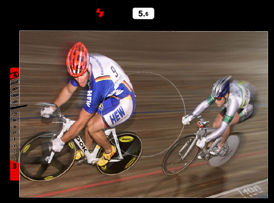 |
Personally, regardless of how old the technology is, I would still rate the TTL flash exposure control feature in the FM3a as one of the few key highlights because this has truly enhanced greatly the performance of the camera and in turns, opens up and simplify the process of many photographic possibilities. |
In order to enable TTL function in the FM3a, there are now additional electrical flash contacts on the accessory shoe at the top of the pentaprism. Basically, this makes all the difference between a FM2n and FM3a when flash photography is concerned. Nikon provides two simple ways of using a flash with the FM3a. You can either use most common flash units available on the market as long as they have a standard ISO-type accessory shoe, in such case, auto and manual flash will be provided. But when you use any Nikon dedicated speedlights (or third party equivalents) that has TTL capability, TTL flash exposure control will automatically function. Another alternative is to use the PC terminal in the front of the camera body for cable connected flash units or third party non-TTL bracket flash units. The main difference is, PC terminal can only provide auto/manual flash control even if you use a TTL flash at this position. Technically, you can also make use of both the PC terminal and the hot shoe to perform multi flash photography but again, TTL flash connecting to PC terminal is not TTL flash enabled.
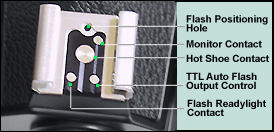 |
Although it can't be considered as a technical innovation measure by modern standard, but TTL OTF flash exposure control incorporating into the FM3a has made the camera the first mechanical Nikon SLRs that provides such capability. Along with its relatively fast 1/250 sync speed, this has greatly enhanced the FM3a's performance as compared to any of the previous FM-class SLR bodies. |
The TTL flash of FM3a works in both manual and auto modes. When the camera is fully setup to use TTL flash photography, it works just like any of the MF Nikon FE2, FA and FG SLR cameras except Nikon has improved the system further in the FM3a by including an innovative flash exposure compensation feature via a simple push a button to supplement TTL flash operation. The FM3a accessory shoe of the camera also has a slight improvement over previous FM/FE/FA series models by providing an additional flash lock when used with newer series of Nikon AF speedlights* to ensure perfect physical contact with the hotshoe and other secondary electrical contacts (see top of the page for illustrations on their respective functions). Further it also serves to prevent accidental slipping off of the flash once mounted. (* 'Speedlight' is a term favoured by Nikon to identify their own series of flash units; others may term theirs as 'Speedlites', 'Program Flash', 'auto-electro flash', 'auto RTS flash' etc. to create separate identity)
By the way, what
the hell is this "TTL OTF" flash metering
?
The TTL ("Through the Lens") OTF ("Off the
Film Plane") flash metering system was first pioneered by Olympus. The Olympus OM2(n)
of 1975 was the first SLR that debuted with this technology. The original OM2 has
three sensors cater for metering, a pair near the eyepiece measures scene brightness
to provide exposure information inside the viewfinder. Another blue photocell is
housed at the base of the mirror box, it takes over during actual exposure, reading
light continuously reflected off surface of the film emulsion when the shutter curtain
is opened until adequate amount of light has been accumulated for good exposure before
it closes the curtain.
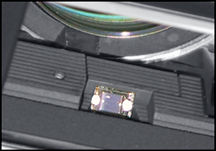 |
This system used on the FM3a, FE2 and even the Nikon FA are very similar to the OM camera in basic concept but the 3 Nikons mentioned use the SPDs near the eyepiece for ambient light metering and use memory switch to store the data for actual exposure. Technically, it has a time delay since it is NOT meters off the film plane REAL TIME as used with the OM2 or other OM bodies that followed) while another dedicated SPD is used to control flash exposure when any dedicated TTL flash unit is used during flash photography. |
<<<<<----- TTL
SPD light sensor essentially for TTL flash of FM3a that locates that faces back to
the shutter curtain. Copyright-free images collection 2002 ![]()
The main difference is, the OM's light sensor in the mirror box is used to handle real time for BOTH ambient and flash TTL OTF metering while the pair of Cds sensors only serve to provide viewfinder metering guide and the Nikon bodies mentioned is solely meant for TTL flash meters off the film plane during flash photography with compatible flash unit(s). Anyway, TTL flash has developed into a mainstream technology employed in many higher range of SLRs. it is a great technology as it simplifies the process of tackling many difficult photographic situations which often requires tedious setup and calculation for good exposure. On the other hand, it assures a more positive result even for beginners for flash photography. Some useful application for TTL flash are, working in multi-flash setup, macrophotography and even for syncro-sunlight photography can't be easier and more confident to handle with this technology.
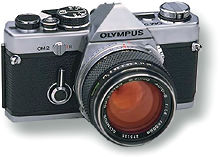 |
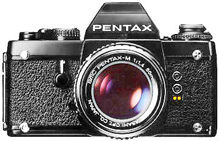 |
This amazing OM-patented TTL OTF metering method can handle both ambient and flash. Thus far, only Pentax LX. has successfully replicated the OM design. Both bodies (and other equivalent OM bodies) are still considered to have the most 'sensitive' metering system, even measured by today's standard. Note: In Auto mode, both cameras can provide exposure reading beyond 2 minutes ! Example: The Pentax LX's metering range is EV - 6.5 to EV20. |
OFF TOPIC SUPPLEMENT: In manual flash photography, the entire power of any given flash unit will be discharged from the flash unit during a flash operation (Depending on the 'power' of the flash, which represents by guide number and you have to divide the guide number by the distance to find out the effective f number i.e.10' divided by a flash with guide number of 20 = f2.0. It is also affected by other variable flash technique e.g. Bounce flash needs compensation as the full output of the flash has been 'disperse' via a medium (such as ceiling etc.), film speed also affects its working range e.g., aperture f4 at ASA/ISO100 will be f5.6 when you change the film to ASA/ISO 200 or when the effective distance is double). Auto flash photography is working via a light sensor built on the flash to sense the reflectance from the subject and its output regulators will cut off the flash output as measured illumination is received and deemed sufficient for a proper flash exposure.. Advantage for auto flash is, it is energy efficient and improves recycling time of the flash. TTL flash metering is more superior than an ordinary electronic flash metering. The sensor is located in the camera body, behind the actual picture taking lens and it measures the amount of light that reflect off the actual film plane to regulate the amount of output from the flash for a proper flash exposure. Theoretically, TTL flash should be a technically more perfect solution for flash metering and exposure than auto and manual flash operations. The raw form of TTL flash design was enhanced further by Nikon with the F90x (and other Nikon bodies that followed), as in most cases, the average TTL flash metering works only like center weighted average metering; however Nikon has successfully transferred their original Matrix metering system to the TTL Flash and now you will find more sophisticated TTL flash has multi segments flash metering. Unfortunately, this works only with flash that has dedicated functions in line with specific cameras that have been designed to take advantage of this technique (The very innovative Contax RTS III is the only camera that has TTL flash metering that works independently, regardless of origin). |
|
Well, the
FM3a does has a delightful touch inside the finder when a compatible flash is turn
on and used. There is a flash ready light built into the viewfinder and enables you
to check the status of the Speedlight while looking through the viewfinder.
Lit: The LED of ready light turns on when the Speedlight is fully charged and ready to flash. The ready light does not light in Bulb mode or if the camera's battery is (batteries are) exhausted. |
Blink: When underexposure is likely with the full-flash output of the Speedlight, the ready light blinks for approx. 3 seconds as a warning soon after firing. In this case, shoot again after checking the focus distance, aperture setting, range of flash shooting distance*, etc. The ready light will also blink as a warning if the shutter speed is set between 1/500 and 1/4000 second. Select a shutter speed below 1/250 second.
* Flash-shooting distance range is range in which the proper exposure can be obtained in flash photograph. The higher the film sensitivity, the wider the range, and vice versa. The wider the lens aperture, the wider the range, and vice versa. Pictures must be taken within the flash shooting distance range.
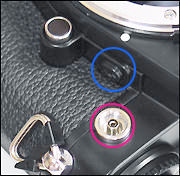 |
Although in theory, TTL seems like the ideal solution to flash photography as TTL flash function automatically controls the level of illumination of the flash by checking the reflectance of the flash from a subject but quite often, it has a slight flaw too. When the ratio of the main subject only occupies portion of the picture frame or its reflectance is underestimated, the level of illumination may become unnecessarily high, thus causing overexposure (such as working distance is too close etc.). |
Nikon patches this by incorporating their innovative multi-segment matrix metering in flash photography into many of the automatic AF SLR bodies. However, since the FM3a has not been provided with such Matrix flash meter, instead - a flash exposure compensation button is provided to reduce excessive flash output onto subject. Flash-exposure compensation is a function to increase/decrease this automatic-level-control range. Shooting with the TTL flash-compensation button pressed can reduce the level of illumination and provide better exposure. When you fire the flash for extra illumination on a main subject with a bright background, you can reduce the level of illumination (exposure is compensated by -1 EV (for less compensation) to achieve desirable exposure by using the TTL flash-compensation button. When activated, there is no indication regarding the flash-exposure compensation in the viewfinder. Note: IF exposure compensation is made with the camera, flash-exposure compensation is also made. If the flash-compensation button is used in combination, the exposure is compensated by another -1 EV .
Note: Nikon has designed many flash units over the years, it is impossible for me to keep track of each and every units especially the newer series which I am not so familiar with. You can mail me your experience with each combination to compile a updated listing here for all others to share. Listed below are function list when used the FM3a with some Nikon AF/Manual Speedlights/Bulbs:
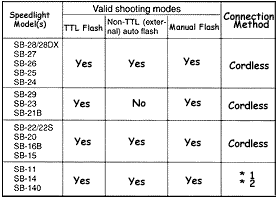 |
|
*2 When you shoot in A or M mode, use the SU-2 in combination with the SC-13 to connect the SB-11 or SB-14, or use the SU-3 with the SC-13, or use the SC-15 with the SC-11 or AS-15 to connect the SB-140.
| Shutter speed (sec.) |
1/4000 |
1/2000 |
1/1000 |
1/500 |
1/250 |
1/125 |
1/60 |
1/30-1 |
B |
Although nowadays flash bulb is rarely used, but here is the chart for proper synchronization when intend to use flash bulb with FM3a. |
| Speedlight | ||||||||||
| M. FP and MF Flashbulbs |
|
Synchronized |
|
Cannot be used |
Flash attachments
with other 3rd
Party Manufacturers
Unless you have cross-checked
with the respective supplier - Nikon advises against using a flash attachment from
other manufacturers. Nikon claims full performance of the camera is best used with
Nikon brand accessories, which no doubt is in the interest of the Company to do so.
Reasons
given being other incompatible brands may apply a voltage of ISO 24V, higher to the
camera's "X" contacts, or otherwise short-circuit the accessory-shoe contacts, resulting in damage to the circuits
in the camera. Come to think of it nowadays, modern SLR cameras are indeed very 'delicate',
I would rather take their advice and not risking causing damages to both flash and
camera sometimes.... I have no further comment on this and should leave you to decide
the appropriate way to make up your mind.
Generally, electronic flash is usually mounted on the camera's accessory shoe and triggered by the electrical contact in the shoe. There is another alternative to fire the flash via the threaded sync terminal on the front of the FM3a, just below the film rewind knob. Some versions of sync-connected flash units (such as powerful bracket mounting flash guns) which use sync cord that can connect to the sync terminal on the camera to fire the flash. However, in such combination - TTL flash is not possible, it allows either only manual or auto flash control. You can also use the sync terminal for off camera operation via sync cord or slave unit(s). It is not unusual to see sync terminal is used by many to operate a secondary flash in a multi-flash operation.
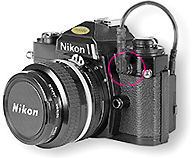 |
Other than flash operation, the threaded sync terminal is sometimes being used for mounting/triggering other older Nikon system accessories. A good example is MF-12 Databack originally designed for FM/FE cameras which operates via the PC sync terminal. The Sync Terminal is usually supplied with a plastic protective cap and it should always keep in place if it is not being used. Generally, as an added safety feature, the hot shoe is automatically disconnected from the synchronization circuit to avoid possibility of mild electrical shock* to the user. Some older accessory such as MF-12 Databack** needs to make use of the PC sync terminal to work. |
* Note: The hot shoe of the camera is switched on by insertion of a flash unit with proper contact at its flash foot; we often use the word "hot" because when it is not mount with any flash, it is not active (remains 'cold'). However, the sync terminal is always remained active ('hot'). When the camera closes it circuits to fire a flash, circuit to the hotshoe and sync terminal closes at the same time. When an electronic flash is used the PC sync terminal may discharge a electrical pulse. If any part of your body is in contact with the sync terminal during the process, there may be a mild electrical shock. Thus it is always advisable to put the plastic cap in place. I always experienced this during old days when operated my Nikon FM, I hope this has been patched over the years. Anyway, other than this possibility, there is no harm of putting the cap in place to avoid foreign particles accumulated into the terminal that may cause improper contact.
** Note: Prior to the original FM2 in 1982, both FM and FE have a old cable connected MF-12 Databack, the FM2(n) and Nikon FE2 has improved it with a revised cableless MF-16 (current model) . However, if the MF-12 can still be safely used on the FM2n, I would assume it can also be used with the FM3a. (do check with Nikon if you have any doubt). The picture shown at right is a typical Nikon FE/MF-12 combination.
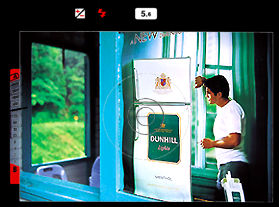 |
Lastly, in relation to compatibility issue, FM3a can use virtually all kind of new and old series of Nikon flash units (Which includes current AF Speedlight units. (I remember there is an AF flash model which has no manual/auto setting that cannot be used with this camera, mail me to update this section), older series of bulb, manual, bracket thyristors and even special application flash such as macro-ringlight, high-speed rapid firing flash or even UV flash etc. The difference could be just confined to restriction of various flash/camera functions. |
For an example, you cannot expect by just mounting an AF SB-28 Speedlight onto the FM3a and expect the FM3a provides second curtain sync flash or when using an old BC-7/BC-3 flash yet expecting the TTL flash feature can be retained. Generally, at worst, you can still made use of the PC terminal if it requires cable to connect an old non-Nikon branded flash, a flash coupler to change the mounting of the flash foot to use other non-dedicated flash etc.
Previous | NEXT | The Viewfinder, Exposure Display and Others
Page 1 | 2 | 3 | 4 | 5 | 6 | 7 | 8 | 9 | 10 | 11 | 12 |
| BACK | to Main Index Page
of Nikon FM3A
|
Other
Issues
relate to Nikon FM3A - Index
Page
|
| Instruction Manual for Nikon FM3A
|
| Technical Specification |
Main
Reference Map
|
Standard
production Nikon FM Series models:-
Nikon FM | Nikon FM2 | Nikon FM2n | Nikon FM10 | Nikon FM3a |
Known
variants:-
Nikon
FM Gold
| Nikon
FM2/T
| Nikon
FM2N Tropical Set
| Nikon
FM2/T Limited Edition
| Nikon
FM2N LAPITA
|
Nion
FM2n Millennium 2000
| Message Board | for
your favourite Nikon
FM Series SLR models
| Message
Board | for your Nikon
Optics in a shared environment
| Message Board | Specifically for Dispose or Looking for Nikon/Nikkor
Photographic Equipment
| Back | Main Index
Page of Nikon FM series Bodies
Shared Resources: MD-11 | MD-12 | Focusing Screens | Titanium Shutter | older dedicated Flash Units for FM series -SB-16 | SB-15 | SB-10 or other Options | Databack | Nikkor lens mount (related info)
Others:- Nikon AF-TTL Speedlights | SB-20 (1986) | SB-22 (1987) | SB-23 | SB-24 (1988) | SB-25 (1991/2) | SB-26 (1994) | SB-27(1997) | SB-28 (1997) | Nikon SB-29(s) (2000) | Nikon SB-30 (2003) | Nikon SB-600 (2004) | Nikon SB-800 (2003) Nikon AF-TTL Speedlight DX-Series: Nikon SB-28DX (1999) | SB-50DX (2001) | SB-80DX (2002) (updated)
Nikon
BC-flash Series |
Original
Nikon Speedlight
SB-2
| SB-3
| SB-4
| SB-5
| SB-6
| SB-7E
| SB-8E
| SB-9
| SB-E
| SB-10
SB-11
| SB-12 | SB-14 | SB-140 UV-IR| SB-15 | SB16A | SB-17 | SB-18, SB-19 | SB-21A (SB-29) Macro flash | Flash Accesories | SF-1
Pilot Lamp
Instruction
Manual: Nikon FM (HTML | PDF) | Nikon FM-10 (HTML) | Nikon FM2n's
User's Manual
available only in HTML format (6
parts) | Nikon FM3A (HTML)
Specifications: Nikon FM, FM-10, FM2, FM2n and FM3A
Main Reference Map: (HTML) Nikon FM, FM2, FM-10, FM2n (Applicable
to FM2T, FM2 "Year of the Dog"; Millennium 2000") and FM3A
| Nikon F | Nikon F2 | Nikon F3 | Nikon F4 | Nikon F5 | Nikon F6 | Nikkormat / Nikomat | Nikon FM | Nikon FE/ FA | Nikon EM/FG/FG20 | Nikon Digital SLRs | Nikon - Other models |
Nikon Auto Focus Nikkor lenses:- Main
Index Page
Nikon Manual Focus Nikkor lenses:- Fisheye-Nikkor Lenses - Circular | Full Frame |
Ultrawides Lenses - 13mm15mm18mm20mm | Wideangle Lenses - 24mm28mm35mm | Standard Lenses - 45mm 50mm 58mm | Telephoto
Lenses - 85mm105mm135mm180mm & 200mm | Super-Telephoto Lenses - 300mm 400mm 500mm 600mm 800mm 1200mm |
 Index Page |
Special
Application lenses: Micro-Nikkor Lenses - 50mm~55mm -60mm 85mm -105mm 200mm Micro-Zoom 70-180mm Perspective Control (PC) - 28mm 35mm PC-Micro 85mm Dedicated Lenses for Nikon F3AF: AF 80mm f/2.8 | AF 200mm f/3.5 EDIF Depth of Field Control (DC): 105mm 135mm Medical Nikkor: 120mm 200mm Reflex-Nikkor Lenses - 500mm 1000mm 2000mm Others: Noct Nikkor | OP-Nikkor | UV Nikkor 55mm 105mm | Focusing Units | Bellows-Nikkor 105mm 135mm Nikon Series E Lenses: 28mm35mm50mm100mm135mm | E-Series Zoom lenses: 36~72mm75~150mm70~210mm |
MF Zoom-Nikkor Lenses: 25~50mm | 28~45mm | 28~50mm | 28~85mm | 35~70mm | 36~72mm E | 35~85mm | 35~105mm | 35~135mm | 35~200mm | 43~86mm | 50~135mm | 50~300mm | 70~210mm E | 75~150mm E | 80~200mm | 85~250mm | 100~300mm | 180~600mm | 200~400mm | 200~600mm | 360~1200mm | 1200~1700mm
Tele-Converters: TC-1 | TC-2 | TC-200 | TC-201 | TC-300 | TC-301 | TC-14 | TC-14A | TC-14B | TC-14C | TC-14E | TC-16 | TC-16A | TC-20E
Recommended links to understand more technical details
related to the Nikkor F-mount and production Serial Number:
http://rick_oleson.tripod.com/index-153.html by: my
friend, Rick Oleson
http://www.zi.ku.dk/personal/lhhansen/photo/fmount.htm by: Hansen,
Lars Holst
http://www.mir.com.my/rb/photography/hardwares/nikonfmount/lens2.htm
http://www.photosynthesis.co.nz/nikon/serialno.html
W A R N I N G: The New G-SERIES Nikkor lenses have no aperture ring on the lens, they CANNOT ADJUST APERTURES with any of these manual focus Nikon FE series SLR camera models; please ignore some portion of the content contained herein this site where it relates.
|
Back | Main Index Page of Nikkor Resources
|
Back | Main Index Page of Pictorial
History of Nikon SLRs
| Message Board | for your Nikkor optics ("shared" because I do wish some of you to expose to other's perspective as well. Isn't it a sad sate to see photography has to be segmented into different camps from the use of various labels)
about this photographic web site
Home - Photography in Malaysia |
Credit: To all the good people who has contributed their own experience, resources or those who are kind enough granting us permission to use their images appeared in this site. Mr. MCLau®, who has helped to rewrite some of the content appeared this site. Chuck Hester® who has been helping me all along with the development of all these Nikon websites;LarsHolst Hansen, 'Hawkeye' who shares the same passion I have; Ms Rissa, Sales manager from Nikon Corporation Malaysia for granting permission to use some of the official content; TedWengelaar,Holland who has helped to provide many useful input relating to older Nikkor lenses; Some of the references on production serial numbers used in this site were extracted from Roland Vink's website; HiuraShinsaku from Nikomat Club Japan. t is also a site to remember a long lost friend on the Net. Note:certain content and images appeared in this site were either scanned from official marketing leaflets, brochures, sales manuals or publications published by Nikon over the years and/or contribution from surfers who claimed originality of their work for educational purposes. The creator of the site will not be responsible for may discrepancies arise from such dispute except rectifying them after verification."Nikon", "Nikkormat", "Nippon Kokagu KK" & "Nikkor" are registered tradename of Nikon Corporation Inc., Japan. Site made with an Apple IMac.
